Each year, between July and August, thousands of wildebeest rush north across the Mara River. They appear like a flock of starlings — a dark and shifting cloud that spreads across the savanna.
Peppered among the wildebeest are zebra, eland, antelope and gazelle. Together, this multi-species convoy embarks annually on a “great migration,” following seasonal rains from the Serengeti to Kenya’s Maasai Mara region in search of pasture. It’s a 1,750-mile round trip full of drama. Calves are born along the way, and thousands of animals perish as they pass through dangerous terrain filled with lions, cheetahs, hyenas and crocodiles that hungrily await their arrival.
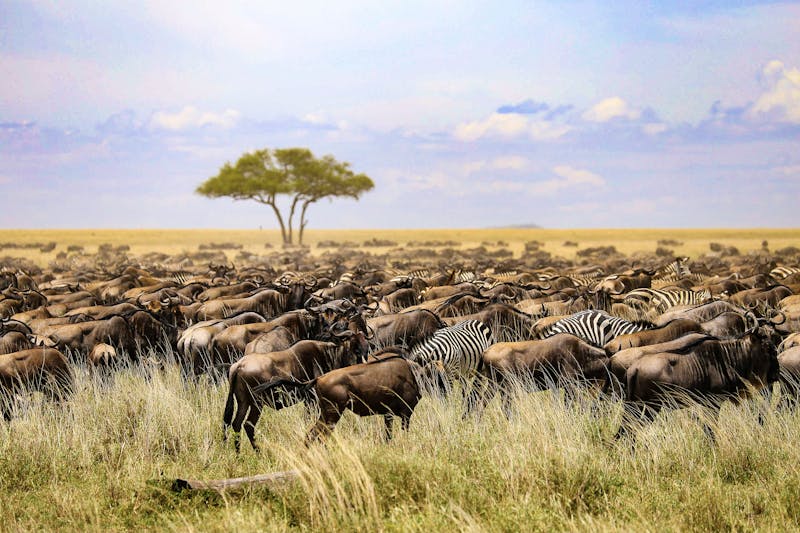 The annual migration of giant herds
of grazers across Tanzania and Kenya. © Leslie Russell
The annual migration of giant herds
of grazers across Tanzania and Kenya. © Leslie Russell
“It may be the most spectacular thing one can experience in their lifetime,” said Daniel Sopia, the chief executive officer of the Maasai Mara Wildlife Conservancies Association, which promotes community-led conservation in the region. “Seeing this absolutely massive group of animals running through the river, dodging attacks by crocodiles — it is truly unbelievable.”
But seeing is believing for the droves of tourists that flock to the site each year, eager for a glimpse of one of the largest movement of animals on Earth. At least until 2020, when everything changed.
The COVID-19 pandemic kept potential travelers at home, slashing tourism revenue in the Maasai Mara by more than 90 percent.
“The Mara absolutely depends on international tourism to pay the bills,” Sopia said. “The pandemic really put people’s livelihoods at risk.”
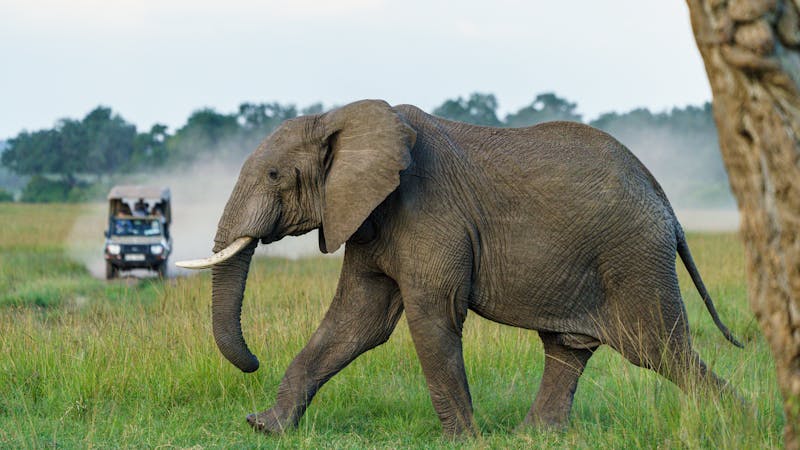 An elephant in a savannah in southwestern Kenya along
the Tanzanian border, Maasai Mara National Reserve. © Jonathan Irish
An elephant in a savannah in southwestern Kenya along
the Tanzanian border, Maasai Mara National Reserve. © Jonathan Irish
Many people in the region make income by leasing their land for safaris, lodges and other tourism activities. As part of the arrangement, the communities protect these lands in “conservancies” — conserved areas that are collectively owned and self-governed by Indigenous communities.
“Conservancies are a life-changing thing,” Sopia said. “Community members can profit from conserving their lands — rather than turning to practices like slash-and-burn farming or poaching for bushmeat in order to survive. Local people can earn income by leasing their land to tourism companies for safaris. And because they can see the tangible benefits of conservation, they are eager to continue to protect the land and wildlife.”
But during the pandemic, with this major revenue stream interrupted, communities faced the difficult choice of replacing lost income by fencing off their lands for grazing, converting it to agriculture or selling to developers — all of which would have brought drastic consequences for the Maasai Mara’s people and biodiversity.
Sopia and others began looking for a way to avert catastrophe.
Together with landowners, tourism partners and others, Conservation International and the Maasai Mara Wildlife Conservancies Association launched the African Conservancies Fund — a rescue package to offset lost revenues for approximately 100,000 people in the area who rely on tourism income.
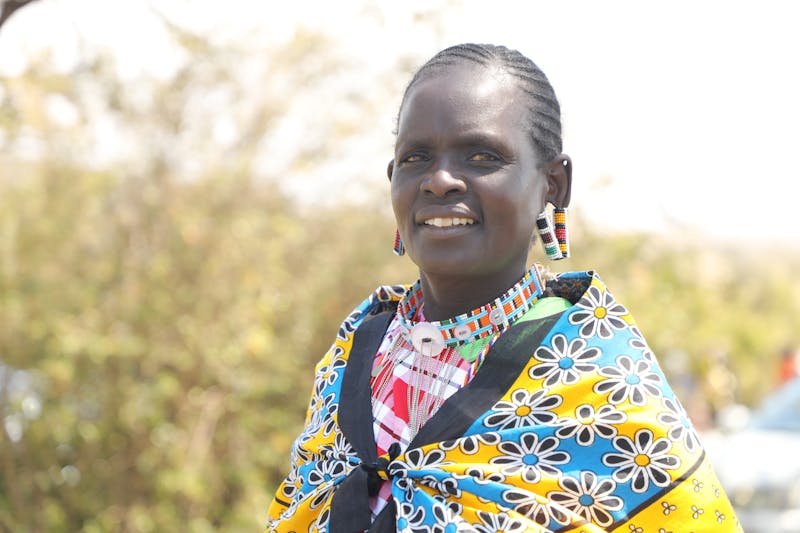 Conservancy landowners' committee member Nailepu Kereto. © MMWCA/William Sankau
Conservancy landowners' committee member Nailepu Kereto. © MMWCA/William Sankau
The African Conservancies Fund lent money to the conservancies, which in turn continued to pay the landowners for the use of their land. This allowed families in the Maasai Mara to continue to pay for health care, home repairs, children’s school fees and more.
And because tourism revenues are the primary source of funding for wildlife protection in the privately owned conservancies, partner organizations such as the nonprofit Maliasili arranged grant funding to ensure wildlife patrols continued normally through the pandemic.
“We currently have about 400 rangers in the Mara,” Sopia said. “Through the pandemic, we didn’t lose a single one. [The rescue package] ensured that all continued to get their full salary, conducting patrols every day.”
Now that tourism in the Maasai Mara is returning to pre-pandemic levels, conservancies have emerged even stronger. They are repaying their loans, and some have even expanded their lands.
What began as a crisis has presented new opportunities. During the pandemic, word began to spread to local people who own land outside of the conservancies that the model was continuing to thrive. Landowners in several communities, including Nyekweri Kimintet, Orpua and Mbokishi, began to commit their own parcels to conservation, helping to establish new conservancies and further expand wildlife corridors.
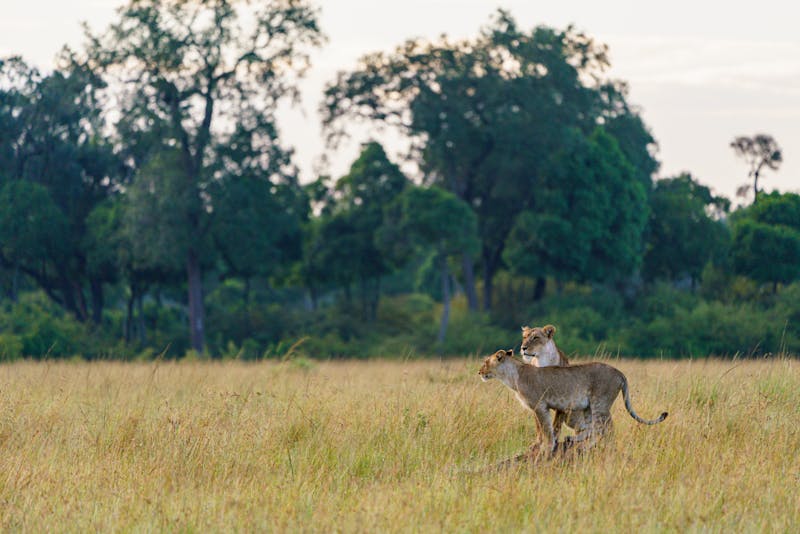
Lions in the Maasai Mara National Reserve. © Jonathan Irish
According to a survey conducted in 2021, 84 percent of large mammal species — including elephants, wildebeest, common zebras and giraffes — live in community conservancies within the Maasai Mara ecosystem. Only a smaller portion, 16 percent, live in protected areas. This makes conservancies, like those that buffer the Maasai Mara National Reserve, critically important to protecting wildlife.
“Initially, our most pressing goal was to provide a bridge of support for conservancies — and the communities that rely on them for income,” said Bjorn Stauch, vice president of CI Ventures, the impact-investing arm of Conservation International that facilitated the fund. “But we also wanted to build a system for long-term stability — a financial safety net that ensures the Mara can remain a thriving place for generations to come.”
As an additional condition of the fund, the conservancies set about improving their operations — and exploring opportunities to build financial resilience to future shocks.
“The conservancies signed binding resolutions designed to strengthen their governance and inclusivity,” Stauch said. “This includes ensuring women and youth representatives are included on their boards and that they are providing training to build the capacity of women leaders.”
For Sopia, the success of the relief package, and the new initiatives that have emerged in its wake, offer further evidence that the conservancies model is here to stay.
“It’s proof that this approach really works,” he said. “If we want to protect wildlife, we need to help people to thrive. Once you do that, things become simpler. I’ve seen it happen time and again — communities and landowners that have struggled to co-exist with wildlife are offered the chance to build livelihoods based on protecting them. Inevitably, they begin to see animals as a benefit and not a burden.”
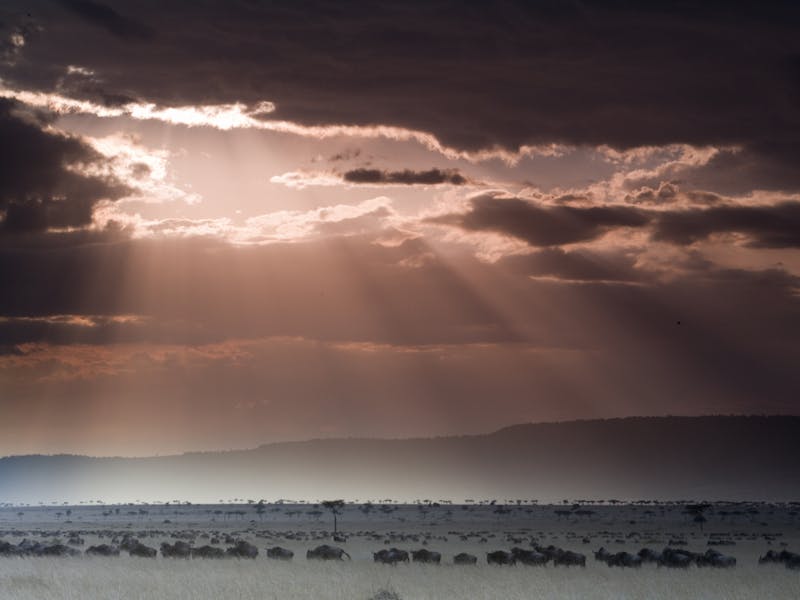 Maasai Mara National Reserve. © Art
Wolfe
Maasai Mara National Reserve. © Art
Wolfe
Will McCarry is a staff writer at Conservation International. Want to read more stories like this? Sign up for email updates. Also, please consider supporting our critical work.
